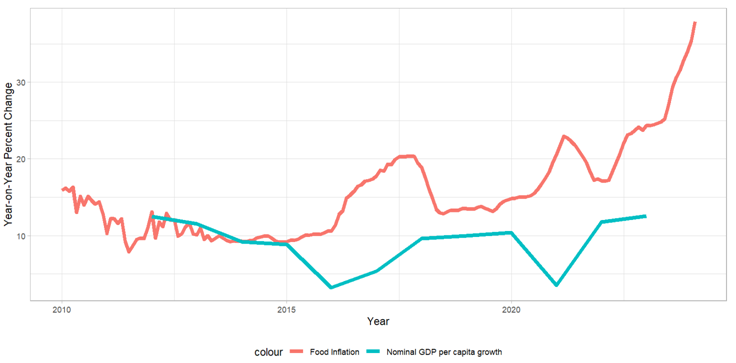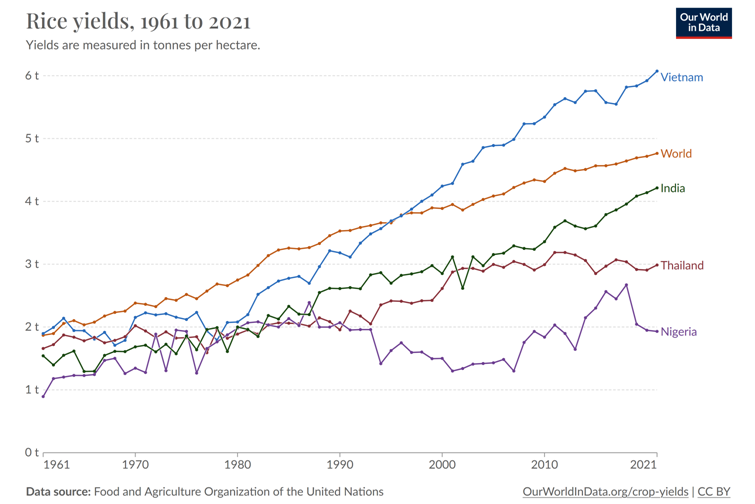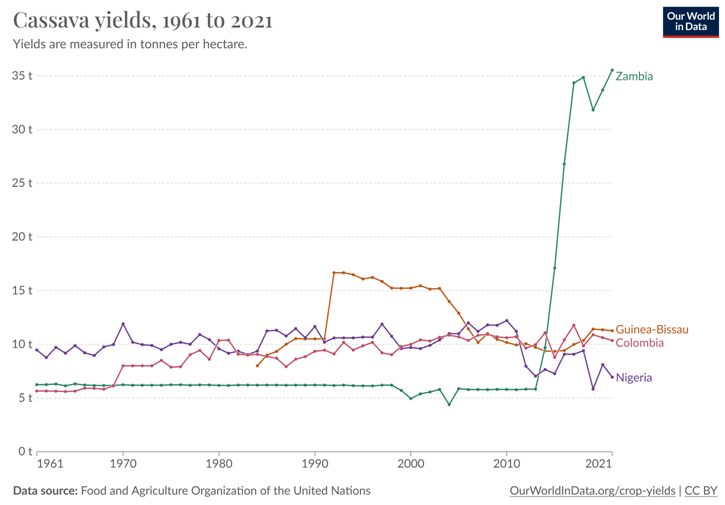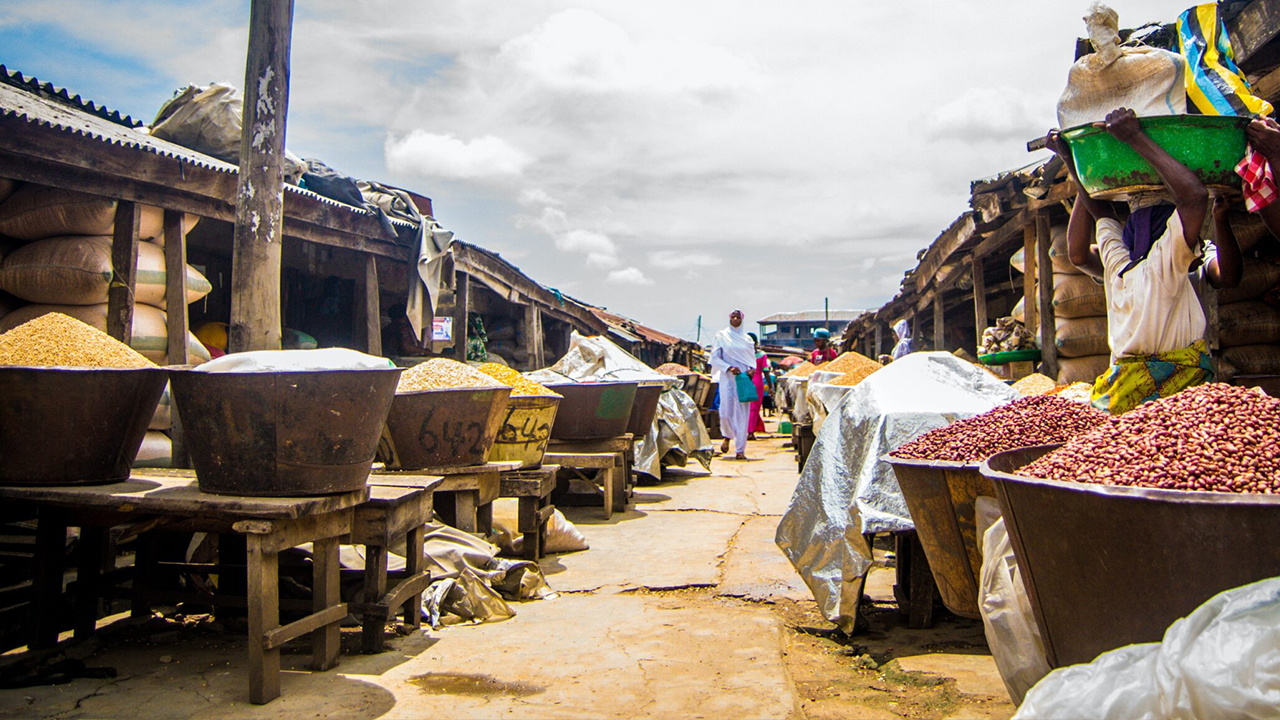By Adebayo Ahmed | The question of food is one that is now on everybody’s lips in Nigeria. The food situation has worsened significantly in the last year partly driven by efforts to turn the economy around in terms of petrol subsidy removal and the foreign exchange market reform. The situation seems dire with increasing cases of violence and civil unrest associated with hunger and with fears that if the situation is not well handled, the country could be headed to the same type of civil unrest witnessed with the COVID19 palliatives in 2020 or worse.

Fig 1: Prevalence of moderate to severe food insecurity. Source: FAOStat
Although the food issue is, or at least should be, top of the agenda right now, the challenge of food security is not really new to Nigeria. According to the Food and Agriculture Organization (FAO), about 34.7% of the population was experiencing moderate to severe food insecurity in the 2014 to 2016 reference period. By any standard, 34.7% was already high. However, the situation worsened almost continuously each year so much so that by the 2020-2022 reference period, an estimated 69.7% of the population was experiencing moderate to severe food insecurity, with 21.3% in the severe category. This worsening trend is backed up by data by the Cadre Harmonise which estimates that 31.5 million households in 26 states plus the FCT are expected to be in crisis in the “lean” season between June and August of 2024. This is up from the 26.5 million people estimated to have been in crisis for the same period in 2023. The total number nationwide is likely higher given that the Cadre Harmonise looks at only 26 states and the FCT. Importantly, the distribution of hunger is nationwide with almost no state spared. The combination of worsening hunger and national spread means that Nigeria is near the top of countries with hunger problems. For example, Nigeria ranks 109th out of 125 countries on the Global Hunger Index1 and 107th out of 113 countries on the Global Food Security Index2.
The rising hunger is not without consequences. According to the Nigeria Demographic and Health Survey, an estimated 37% of Nigerian children under five years of age are stunted, meaning they do not develop to their full potential. According to UNICEF3, an estimated two million children already suffer from “severe and acute malnutrition”. This likely contributes to our under-five mortality rates of 107.2 per 1000 live births, the third highest of all countries compiled according to data from the World Bank4. Given our population relative to others, it implies that globally, a large number of children who die before the age of five from reasons, including hunger, are from Nigeria. Although the current situation seems more dire than normal, it is important to accept that this hunger crisis is not a one-off problem.t is a problem that has worsened continuously over a long period of time.

Fig 2: Food Inflation and Nominal GDP per capita growth. Source: NBS and Author’s calculations
Causes of Food Security Crisis
The causes of the food security crisis are actually very simple and can be thought of from two perspectives. The first being that food prices have risen systematically faster than household incomes. As is clear from Figure 2 above, average incomes have grown significantly slower than food prices since 2015. This means households have been getting continuously squeezed and food has become increasingly unaffordable. The measure of average income used here is simply average nominal GDP per capita but if you incorporate income inequality then it is likely you will see a tighter squeeze at the lower end of the income ladder. Things have gotten worse in the last year but it should be clear to all that the situation has been brewing for almost a decade.
The causes of rising food prices have been rehashed over and over again but they are worth repeating regardless. Monetary policy has been loose, leading to the classic demand push inflation of more money chasing fewer goods. Trade policy has been restrictive, leading to supply disruptions which have put upward pressure on food prices. Interstate logistics continues to be challenging, leading to a wide variation in prices across the country and household paying more than they could have been paying if logistics were better. Farming techniques continue to be “traditional” and rain-driven, leading to mostly low agricultural yields. Climate change has made it more difficult for farmers to produce reliably. The security situation has continued to worsen especially in key agricultural areas, limiting access to usually productive farmlands. And so on.
The last point highlights the second perspective for the cause of the worsening food crisis: livelihoods i.e. whatever people do to earn a living. To be clear, livelihoods here does not refer only to those of farmers, but to barbers and street vendors, and bankers, and so. And as can be seen from the 2023 Cadre Harmonise which estimated the distribution of food insecurity by state, there are more people under hunger stress in Lagos State than in any other state. The majority of people in Lagos are not employed in the agriculture sector. Food prices may rise fast enough that even people whose livelihoods are not disrupted can become food insecure. But the other perspective is that people’s livelihoods may be disrupted so that even with the same food prices, they no longer have the capacity to afford to keep themselves out of food insecurity.
The disruption to livelihoods in rural communities is a good place to start in thinking about this perspective. The deteriorating security situation and climate change are both combining to make earning a livelihood from agriculture increasingly difficult. Farmers in many communities cannot access lands because of terrorists, bandits, kidnappers, and so on. In other places where they can access land, climate change is leading to more irregular weather, making their production more volatile thus impacting their livelihoods. On the urban front, the absence of decent job growth and almost consistent economic shocks, from the 2015 oil price crash to COVID19, to recurring foreign exchange crises, have put a similar dent on livelihoods and income growth. Both factors mean that almost everyone is now feeling the squeeze, though the poor (who are in the majority) are disproportionately impacted.
The Path Out of the Crisis
Given that the crisis is seemingly largely about affordability, the path out of the crisis likely involves tackling affordability both immediately and in the long-term. In terms of immediate responses, the key is to on the one hand get money directly into the pockets of households, and on the other hand take action to put downward pressure on food prices. The government, at the federal, state, and local levels, should have a lot more money flowing to their coffers given that petrol subsidies were removed, and that the weakening of the national currency should mean more Naira from crude oil revenues. Re-directing some of this windfall directly into the pockets of Nigerians would automatically improve their capacity to afford food and will do so immediately. There has been talk of a cash transfer programme by the Ministry of Finance with 15 million households targeted. It is however time for more action and less talk. And of course, states and local government areas that are also benefitting from the windfall should not be let off the hook.
Some may argue that there is a risk of putting even more pressure on inflation if more money is funneled directly to households. This does not have to be the case in practice. If the social transfers are funded by already existing revenue and not by an increase in money supply through increased domestic debt or central bank financing, then the impact on inflation should be minimal.
And of course, putting money into the pockets of households however has to go hand in hand with other attempts to increase food supply and put downward pressure on food prices. On this, there are many short-term options on the table. Can we do anything to immediately reduce the portion of food prices that is due to logistical challenges and corruption on the highways? Does it make sense to have a sixty to seventy percent tariff plus duty on imported wheatand rice, at a time when food prices are relatively sky-high and unaffordable?
Dealing with the currency issues, which has resulted in the Naira weakening so much that most food items in Nigeria are cheaper than in some neighbouring countries also needs to be resolved. International demand for food items from Nigeria has increased putting upward pressure on prices. A weakening Naira means that food traders would rather collect foreign currency than sell to domestic consumers. As the currency weakens further, domestic prices for tradeable food items would have to adjust which would worsen the affordability challenges. The problems on the macroeconomic front transmit to very real challenges. Stabilising things on the macroeconomic front, specifically the exchange rate, is therefore a necessary part of the immediate measure to deal with the challenge.
On a related note, it may be tempting to try to limit the impact of the exchange rate on food prices by other means such as trying to limit cross-border trade or trying to increase domestic supply to keep domestic prices lower than prices in neighbouring countries. Both temptations are likely to be unsuccessful. We have a long history of trying and failing at restricting regional trade and the only likely result of attempts to do that now would be more smuggling and more illicit and informal trade. More importantly, restricting trade today would disincentivise farmers from doing all they can to boost domestic output tomorrow and reap the rewards of demand from international markets. The same can be said for releasing food items from strategic reserves. Given the strong demand from neighbouring countries, the food items would likely simply flow there, unless maybe they are distributed directly to households.
Longer-term Solutions
Beyond the immediate term, the longer-term solutions have to revolve around reversing the trends observed in Figure 2. That is, working to ensure that average incomes grow faster than food prices.
Conventional macroeconomic management is the starting point for ensuring that food inflation does not spiral out of control like it has done in the recent past. This means having money supply that is not growing systematically too fast, and continuing to diversify exports to minimise the risk of currency crises. In the face of macroeconomic challenges, even excellent policy on all other fronts will struggle to yield the desired results.
Improving incomes and resilience of households is the second major long-term agenda. The richer the household, the more likely they will be able to cope with food price shocks. The institutionalisation of social protection will also help ensure that households have something to fall back on in the event of more serious shocks. In this context, it is important to realise that improving resilience is not just about rural farmers but also about urban poor households, or those who are at risk of falling into poverty. For urban households, this means better jobs.

Fig 3 - a; Rice yields

Fig 3 - b: Tomato yields

Fig 3 - c: cereal yields

Fig 3 - d: Cassava yields
For rural agriculture-based households, this means improving productivity. Agricultural productivity is still relatively low and this is one of the foundations for domestic supply problems and high food insecurity in rural communities. As is clear from the yield on rice, tomatoes, cereals, and even cassava, yields in Nigeria are relatively very low. Improving productivity should therefore be the number-one agenda. This agenda would involve transforming farmers from subsistence farmers who farm to survive, to entrepreneurs who farm to get incomes. Turning farmers to entrepreneurs would have to involve investments in yield-improving infrastructure such as irrigation facilities, improving seedlings and seeds’ availability, improving knowledge about best practices through better extension services, improving rural security, improving resilience to climate change, improving farm-to-market infrastructure and logistics. And so on. As shown in Figure 4, the difference in prices between states is so large that just cutting logistics costs from moving food around can have a significant impact on reducing prices.

However, working to improve domestic supply and reduce costs is not enough. It is also important to build on and improve resilience to shocks in supply. This does not only involve producing more food. It involves two other factors, the first of which is storage. Storage, in the simplest of terms, is keep food when things are good to eat when things are not so good. The cyclical nature of our weather patterns in Nigeria means that we are no strangers to the importance of food storage, even if occasionally we like to throw around words like hoarders and saboteurs. Improving the quality and organisation of storage facilities should mean we are better able to cope with shocks to supply.
The second factor is trade. International trade. Leveraging international trade and building strong trade networks essentially ensures that supply is more resilient. For example, if domestic demand for a particular food item is more than current domestic supply, perhaps because the rains did not arrive on time, or because a flood damaged some output, or because the farmers techniques were not that great, international supply helps minimise the risks that the demand-supply gaps would cause scarcity or price increases. The same applies for situations when supply outstrips demand. International trade ensures that excess supply can go somewhere else and not lead to a price collapse which would also hurt livelihoods of farmers.
The second factor is trade. International trade. Leveraging international trade and building strong trade networks essentially ensures that supply is more resilient. For example, if domestic demand for a particular food item is more than current domestic supply, perhaps because the rains did not arrive on time, or because a flood damaged some output, or because the farmers techniques were not that great, international supply helps minimise the risks that the demand-supply gaps would cause scarcity or price increases. The same applies for situations when supply outstrips demand. International trade ensures that excess supply can go somewhere else and not lead to a price collapse which would also hurt livelihoods of farmers.
Getting to grips with the food security challenge is urgent but there are enough tools available to the government to turn things around and ensure that we do continue to be one of the basket cases of hunger in the world. But it will require quick action to do things today, and the foresight and the stamina to undertake more long-term, strategic and coordinated actions to remove Nigeria permanently from the hunger map. The current episode of high food prices should raise the status of the lingering food security challenges in Nigeria and propel policy makers to take immediate and longer-term decisions to sustainably reverse the trend. Food security should be seen as national security.
Photo Credit: Mansur Ibrahim
Footnotes
[1] https://www.globalhungerindex.org/nigeria.html
[2] https://impact.economist.com/sustainability/project/food-security-index/explore-countries/nigeria
[3] https://www.unicef.org/nigeria/nutrition
[4] https://data.worldbank.org/indicator/SH.DYN.MORT?most_recent_value_desc=true





